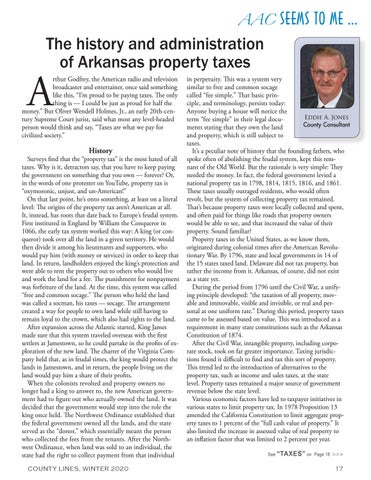AAC
SEEMS TO ME ...
The history and administration of Arkansas property taxes
A
rthur Godfrey, the American radio and television broadcaster and entertainer, once said something like this, “I’m proud to be paying taxes. The only thing is — I could be just as proud for half the money.” But Oliver Wendell Holmes, Jr., an early 20th-century Supreme Court jurist, said what most any level-headed person would think and say, “Taxes are what we pay for civilized society.”
History
Surveys find that the “property tax” is the most hated of all taxes. Why is it, detractors say, that you have to keep paying the government on something that you own — forever? Or, in the words of one protester on YouTube, property tax is “oxymoronic, unjust, and un-American!” On that last point, he’s onto something, at least on a literal level: The origins of the property tax aren’t American at all. It, instead, has roots that date back to Europe’s feudal system. First instituted in England by William the Conqueror in 1066, the early tax system worked this way: A king (or conqueror) took over all the land in a given territory. He would then divide it among his lieutenants and supporters, who would pay him (with money or services) in order to keep that land. In return, landholders enjoyed the king’s protection and were able to rent the property out to others who would live and work the land for a fee. The punishment for nonpayment was forfeiture of the land. At the time, this system was called “free and common socage.” The person who held the land was called a socman, his taxes — socage. The arrangement created a way for people to own land while still having to remain loyal to the crown, which also had rights to the land. After expansion across the Atlantic started, King James made sure that this system traveled overseas with the first settlers at Jamestown, so he could partake in the profits of exploration of the new land. The charter of the Virginia Company held that, as in feudal times, the king would protect the lands in Jamestown, and in return, the people living on the land would pay him a share of their profits. When the colonists revolted and property owners no longer had a king to answer to, the new American government had to figure out who actually owned the land. It was decided that the government would step into the role the king once held. The Northwest Ordinance established that the federal government owned all the lands, and the state served as the “donor,” which essentially meant the person who collected the fees from the tenants. After the Northwest Ordinance, when land was sold to an individual, the state had the right to collect payment from that individual COUNTY LINES, WINTER 2020
in perpetuity. This was a system very similar to free and common socage called “fee simple.” That basic principle, and terminology, persists today: Anyone buying a house will notice the Eddie A. Jones term “fee simple” in their legal docuCounty Consultant ments stating that they own the land and property, which is still subject to taxes. It’s a peculiar note of history that the founding fathers, who spoke often of abolishing the feudal system, kept this remnant of the Old World. But the rationale is very simple: They needed the money. In fact, the federal government levied a national property tax in 1798, 1814, 1815, 1816, and 1861. These taxes usually outraged residents, who would often revolt, but the system of collecting property tax remained. That’s because property taxes were locally collected and spent, and often paid for things like roads that property owners would be able to see, and that increased the value of their property. Sound familiar? Property taxes in the United States, as we know them, originated during colonial times after the American Revolutionary War. By 1796, state and local governments in 14 of the 15 states taxed land. Delaware did not tax property, but rather the income from it. Arkansas, of course, did not exist as a state yet. During the period from 1796 until the Civil War, a unifying principle developed: “the taxation of all property, movable and immovable, visible and invisible, or real and personal at one uniform rate.” During this period, property taxes came to be assessed based on value. This was introduced as a requirement in many state constitutions such as the Arkansas Constitution of 1874. After the Civil War, intangible property, including corporate stock, took on far greater importance. Taxing jurisdictions found it difficult to find and tax this sort of property. This trend led to the introduction of alternatives to the property tax, such as income and sales taxes, at the state level. Property taxes remained a major source of government revenue below the state level. Various economic factors have led to taxpayer initiatives in various states to limit property tax. In 1978 Proposition 13 amended the California Constitution to limit aggregate property taxes to 1 percent of the “full cash value of property.” It also limited the increase in assessed value of real property to an inflation factor that was limited to 2 percent per year. See
“TAXES” on
Page 18
>>>
17
















